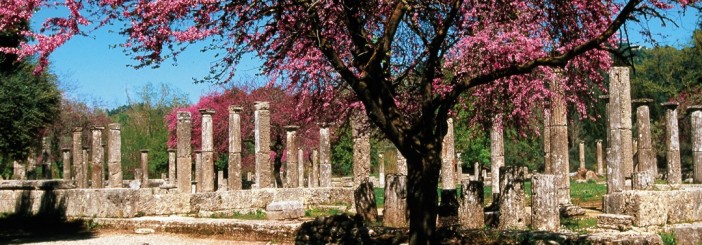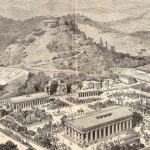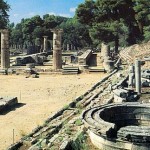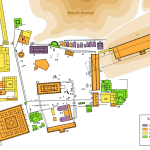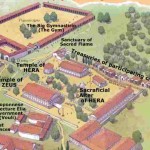In the western Peloponnese, just 38 km (24 miles) from the port of Katakolon, in the “Valley of Gods”, lies the most celebrated sanctuary of ancient Greece, Olympia. The name Olympia, which described the wooded valley where the site was located, referred to the sacred mountain of Olympus, the habitual residence of the Greek gods.
Dedicated to Zeus, the father of the gods, it sprawls over the southwest foot of Mount Kronios, at the confluence of the Alpheios and the Kladeos rivers, in a lush, green landscape, becoming the most important religious and athletic centre in Greece. Its fame rests upon the Olympic Games, the greatest national festival and a highly prestigious one world-wide, which was held every four years throughout Classical Antiquity, from the 8th century BC to the 4th century AD to honor Zeus. The origin of the cult and of the festival went back many centuries. Local myths concerning the famous Pelops, the first ruler of the region, and the river Alpheios, betray the close ties between the sanctuary and both the East and West.
HISTORY
In 776 BC, Iphitos, king of Elis, Kleosthenes of Pisa and Lykourgos of Sparta reorganized the Olympic Games in honour of Zeus and instituted the sacred ekecheiria, or truce. The great development of the sanctuary began in the Archaic period. This is when the first monumental buildings were constructed – the temple of Hera, the Prytaneion, the Bouleuterion, the treasuries and the first stadium. The sanctuary continued to flourish into the Classical period when the enormous temple of Zeus (470-456 BC) and several other buildings (baths, stoas, treasuries, ancillary buildings) were erected, and the stadium moved to the east of its Archaic predecessors, outside the Altis. The countless statues and precious offerings of this period were unfortunately lost, as the sanctuary was pillaged several times in antiquity and especially under Roman rule. In the Hellenistic period the construction of lay buildings, such as the gymnasium and palaestra, continued, while in Roman times several existing buildings were refurbished and new ones built, including hot baths, luxurious mansions and an aqueduct. Many of the sanctuary’s treasures were removed and used for the decoration of Roman villas.
The sanctuary continued to function during the first years of Christian rule under Constantine the Great. The last Olympic Games were held in 393 AD, before an edict of Theodosius I prohibited all pagan festivals. In 426 BC Theodosius II ordered the destruction of the sanctuary. In the mid-fifth century AD a small settlement developed over the ancient ruins and the Workshop of Pheidias was transformed into a Christian church. In 522 and 551 the ruins were devastated anew by earthquakes, the Temple of Zeus being partially buried. In subsequent centuries the Alpheios and the Kladeos overflowed and together with landslips from Mount Kronios buried the site deep in mud and sand. Olympia remained forgotten under a layer of debris 5-7 metres deep. The area was dubbed Antilalos and it is not until 1766 that the ancient sanctuary was re-discovered.
In 1829 the French Scientific Expedition of the Peloponnese partially excavated the Temple of Zeus, taking several fragments of the pediments to the Musée du Louvre. Systematic excavation began by the German Archaeological Institute in 1875 and continues to the present. During this last decade U. Sinn, Professor of Classical Archaeology at the University of Würzburg, and his team researched the southwest building, while Dr. H. Kyrieleis, former director of the German Archaeological Institute, and his team excavated the Prehistoric buildings of the sanctuary. Several monuments of the site are currently under conservation and restoration.
DESCRIPTION
The Archaeological Site of Olympia includes the sanctuary of Zeus and the many buildings erected around it, such as athletic premises used for the preparation and celebration of the Olympic Games, administrative buildings and other lay buildings and monuments. The Altis, the sacred enclosure and core of the sanctuary, with its temples, cult buildings and treasuries, occupies the centre of the site.
The classical Temple of Zeus and the earlier Temple of Hera dominate the Altis. East of the Heraion is the Metroon, a temple dedicated to Rhea, the mother of the gods, and behind this, a row of treasuries dedicated by Greek cities and colonies. To their west lies the Nymphaion, a splendid fountain dedicated by Herodes Atticus. South of the Heraion and over the remains of the prehistoric settlement of Olympia is the Pelopion, a funerary monument commemorating the hero Pelops. Also within the Altis are the Prytaneion, the see of the sanctuary officials, and the Philippeion, an elegant circular building dedicated by Philip II, king of Macedon. Southeast of the Heraion was the great altar of Zeus, the most important monument entirely made of ashes and therefore now completely lost. The remaining space inside the Altis was filled with numerous altars and statues of gods, heroes and Olympic winners dedicated by Greek cities or wealthy individuals.
Outside the sacred precinct of the Altis, are the Bouleutherion and the South Stoa, the southernmost building of the greater sanctuary and its main entrance from the south. West of the Altis and separated from it by the Sacred Road is a series of buildings for the sanctuary personnel, the athletes and the distinguished visitors: the gymnasium and palaestra, exercise grounds, the Workshop of Pheidias, which in Late Antiquity was transformed into a Christian church, the Greek baths with their swimming pool, the Roman hot baths, the Theokoleion or priests’ residence, the Leonidaion or officials’ quarters, and the Roman hostels.
East of the Altis lies the stadium where the Olympic Games were held. South of the stadium was the hippodrome, of which no trace remains as it was swept away by the Alpheios. South of the hippodrome is a group of mansions and baths, including the famous House of Nero, built by the emperor for his stay at Olympia during his participation in the games.
SITE MONUMENTS
The Stadium of Olympia, situated east of the sacred Altis enclosure, was where the ancient Olympic Games and the Heraia, the women’s games in honour of Hera, were held. Before the sixth century BC the running events were held on a flat area along the treasuries’ terrace, east of the great altar of Zeus. A first stadium (Stadium I) was formed in the Archaic period (mid sixth century BC) by leveling the area south of the Kronios hill inside the Altis. The west short side of the stadium faced the altar of Zeus, to whom the Games were dedicated. In the late sixth century BC a new stadium (Stadium II) was created east of its predecessor, with a racetrack extending beyond the treasuries’ terrace; an artificial bank, three metres high, was formed along the south side, while the hill side formed a natural seating area along the north. The stadium received its final form (Stadium III) in the fifth century when the great temple of Zeus was built. By then the Games had become very popular, attracting a great number of both visitors and athletes, so a new stadium was deemed necessary. The new stadium was moved eighty-two metres to the east and seven metres to the north and was surrounded by artificial banks for the spectators. After the construction of the Echo-hall in the mid-fourth century BC the stadium was isolated from the Altis which shows that the Games had lost their purely religious character and had become more of an athletic and social event.
The early German excavations first investigated the race track, but the recent German excavations of 1952-1966 uncovered the entire monument.
In the 2004 Olympic Games in Athens, the ancient stadium of Olympia hosted the men’s and women’s shot put competition, crowning once more Olympic champions after 17 centuries of silence.
The massive Temple of Zeus, the most important building in the Altis standing in its very centre, is the largest temple in the Peloponnese, considered by many to be the perfect example of Doric architecture. It was built by the Ilians and dedicated to Zeus. Construction began 470 BC and was completed before 456 BC. The temple was burnt by order of Theodosius II in AD 426. Badly damaged by the fire, it was finally thrown down by the earthquakes of AD 551 and 552. Excavations at the temple began by the French in 1829 and were completed by the German School. Parts of the sculptural decoration have been restored and are now on display in the Olympia Archaeological Museum, while the metopes removed by the French expedition of 1829 are in the Louvre. Conservation and cleaning of the monument are currently in progress.
The Temple of Hera is one of the oldest monumental temples in Greece which was dedicated to the Olympian sanctuary by the inhabitants of Skillous, an ancient city of Ilia. The theory that the entire temple was built around 600 BC prevails today. The temple was refurbished on many occasions, and the Romans transformed it into a kind of museum for the sanctuary’s choicest treasures, such as the famous Hermes by Praxiteles. Only the temple’s basement with its massive orthostates and lower part of the columns are visible in its original place. Fragments of the terracotta entablature and the central akroterion are displayed in the museum.
The Shrine of Pelops (or Pelopion), south of the Heraion, was a funerary monument dedicated to Pelops, the first ruler of the region (king of Pisa in the Peloponnese). According to Pausanias, this monument was dedicated by Hercules, a descendant of Pelops. Beneath the Pelopion lies a prehistoric tumulus and its enclosure. The earliest structure inside the Altis, its top was still visible in the Classical period.
It was enclosed by a perimeter wall which was circular at first, but this was replaced by a polygonal one with an elaborate propylon (gatehouse) in the sixth century BC. Inside the enclosure were trees, mostly poplars, and statues. According to Pausanias, once a year the magistrates sacrificed a black ram to honor Pelops and whoever ate from the sacrificed animal was not allowed to enter the temple of Zeus.
The Council House (or Bouleuterion), one of the most ancient and important buildings of the sanctuary of Olympia, was the seat both of the Ilian Senate, whose members were responsible for the organisation of the games, and possibly of the hellanodikai, or umpires. This is where the athletes registered and drew lots, and where their names and the program of events were announced. It was also where any offences and pleas were tried, and where penalties were decided. Situated south of the temple of Zeus, outside the sacred precinct of the Altis, the building was begun in the sixth century BC and completed in the fourth century BC; small additions and changes were made in the Roman period.
Here, according to Pausanias, competitors, their relatives and their trainers swore that they would be guilty of no foul play in the games, and judges swore that they would be fair and would not accept bribes. During this procedure athletes and judges stood on wild boars’ genitals. An inscription at the statue’s feet contained curses and penalties for the perjurers.
Only the building’s foundations have survived. There has been limited restoration and the area around the monument has been planted with trees.
VISITING OLYMPIA
Olympia is one of the most well known tourist destinations in Greece and one of the most powerful brand names worldwide. It is one of the sites that should be included in any itinerary of Greek site-seeing. It is also one of the easiest archaeological sites to traverse since it has fairly level wide paths to walk through, lavatories, and plenty of shade under the many trees.
The visitors can run in the ancient stadium; just as the ancient Olympians did after their victory 3000 years ago. They can also visit the museum and get the chance to see some unbelievable sculptures such as the sculpted decoration of the temple of Zeus, one of the Seven Wonders of the Ancient World, the famous Hermis of Praxiteles and the statue of Nike of Paionios.
The archaeological site and museum are within walking distance from the Modern Town of Olympia (about 5 – 10 minute walk).
The Archaeological Site of Olympia is open every day to the public between 08.00am and 20.00pm from April 1st till October 31st and between 08.00am and 15.00pm from November 1st till March 31st.
Tickets:
Full: €12, Reduced: €6
Reduced admission for:
⦁ Citizens of the European Union aged over 65 years old
⦁ Students of Higher Education Institutes and equivalent Schools from countries outside the EU
Free admission for:
⦁ Young people under the age of 18 years old
⦁ Cultural Card holders
⦁ Journalists
⦁ Persons accompanying blind and disabled
⦁ Tourist guides after demonstrating their professional identity of the Ministry of Culture and Tourism
⦁ University students of the E. U. and students at Schools of Tourist Guides
Free admission days:
⦁ 6 March (in memory of Melina Mercouri)
⦁ 18 April (International Monuments Day)
⦁ 18 May (International Museums Day)
⦁ 5 June (International Enviroment Day)
⦁ The last weekend of September annually (European Heritage Days)
⦁ Every first Sunday from November 1st to March 31st
⦁ 28 October
Holidays:
⦁ 1 January (closed)
⦁ 25 March (closed)
⦁ 1 May (closed)
⦁ Easter Sunday (closed)
⦁ 25 December (closed)
⦁ 26 December (closed)





